It’s me, Steve. He/They. TTRPG stuff. Forever working on nothing in particular.
Don't wanna be here? Send us removal request.
Text
It’s that time of year again, adventure calls!
Taking part in Evey Lockhart’s casual October TTRPG prompts. Imma do at least three.


Check out the prompt list here:
3 notes
·
View notes
Text
Villainations on a Theme
Thinking up titles for these posts is the hardest part. Something else that’s difficult is trying to create variety in villains while writing a mega-dungeon. I first took the route of having the villain pop up here and there, to make them known, and give the adventure party a chance to interact with them. These interactions set the tone of who this person is. But in the last third of the dungeon, I started to really lean in on playing with different incarnations of the villain, to lean on some of the original facets of their core personality, but then also explore what they might be like if they had lost everything in their life, if they were all-powerful, if they were a puddle of living oil – things like that.

See, this particular villain has a cloning machine that they use to clone themselves. An aspect of the adventure is that some of these clones have become aberrant, gaining unique powers of their own, or having different circumstances that cause them to diverge from the standard archetype of the villain I first started with. I don’t think I would have done this with a smaller adventure/dungeon, so it’s been an interesting side effect of writing a mega-dungeon where I am constantly scraping by, trying to generate unique ideas to come up with something new. It’s good mental exercise.
I don’t know if this approach works for everyone, but quantity has been effective in sifting out quality for me. That is, writing a lot helps to unearth interesting ideas. Proof to me that it’s worth sitting down and writing a little every day, even if everything that’s on the page doesn’t make it into a final draft. So much of what ended up in the final version did not exist last year during my initial drafts. 20 months later, the mega-dungeon has taken on a life of its own. Even in the final hours of writing yesterday, certain things just fell into place that I had not even been thinking about. It’s a unique sensation when things click like that.
I’ve come to a close on this mega-dungeon, finally. All 12 areas are complete, and I managed to squeeze in an intro and some adventure hooks. 240 pages, last I counted. I’ll likely do one more pass of proofreading, undoubtedly there are still typos, or miss-referenced locations. But it’s a load off for sure. Time to take a breather and focus on something new for a while. I appreciate everyone who has come along for the ride, thank you!
Things I’ve Been Playing
Role-playing adjacent, I picked up a very unique game called “Lost Worlds”. I had never heard of it before, and happened upon a stack of the play books at my local game store. It’s a game from the early 80s, and the mechanics are so utterly novel to me. It’s nice to be surprised.
The best way I can describe it, is a mix between a choose-your-own adventure book, and a one on one character fighting game, ala Street Fighter, but with a fantasy theme. It’s all done with a couple of books. You and your opponent each have a character card that lists your moves like “down swing”, “thrust” and other “special” attacks.
Then you exchange your book with your opponent and shout numbers at each other to perform your character’s moves. The numbers are listed on a matrix that correspond to pages. The matrix combinations define who parries, who hits, etc.
It’s fun not knowing exactly what move your opponent is going to pick, and when you have an advantage, you can press on it by picking a move that would score you a hit. There is a real sense of action. No dice, more of a rock-paper-scissors strategy with extra layers. It’s impressive, all being done with a couple of small chapbooks.
Without knowing how it all works, it’s a bit like magic. After researching how it works (I won’t spoil it), it’s still pretty special. I could go on. So I will.
Another interesting thing about these books, the fact that the illustrations depict the action in first person. Meaning once you’ve exchanged your book with your opponent, you are seeing their character through your character’s eyes. That is, you see an illustration of them attacking you, or blocking your attacks. Pretty much every situation is accounted for. Fascinating stuff that I have just not seen anywhere else in this format.
I guess this was based on an older game called Ace of Aces. An aerial combat game with similar mechanics. A bit of a rabbit hole for me, for sure. Love digging into this kind of thing.
And of course, you can run campaigns, and your characters can level up. It also mentions using the Lost Worlds battle system in place of traditional RPG combat, taking your Lost World characters into your favourite dungeon adventures. The game was popular in DnD’s early days – if I manage to get a B/X or OSE game up and running one of these days, I might just try this mash-up.
—
Alright, that’ll do for now. I believe I’ll take a break for a bit – see you around!
Oh yeah, go back Get it at Sutlers! Everyone needs a little more Troika! in their lives.
#ttrpg#dungeon23#ttrpg maps#dnd#indie ttrpg#inkdrawing#ttrpg art#drawing#ttrpgs#osr#lost worlds#retro games#pen and paper
10 notes
·
View notes
Text
Brute Force Adventure Writing?
I’ve found success lately by writing my 1D6 tables as 1D8 tables, then cutting the two least interesting options. Even if I write just one extra option and make a cut, it tends to make a stronger encounter table. A 1D4 table? Write five options, review and cut the most boring or repetitive one. Write lots, keep what’s best. Is this brute force adventure writing? Or like just, normal editing? I don’t know. I’m not a professional. But it works.
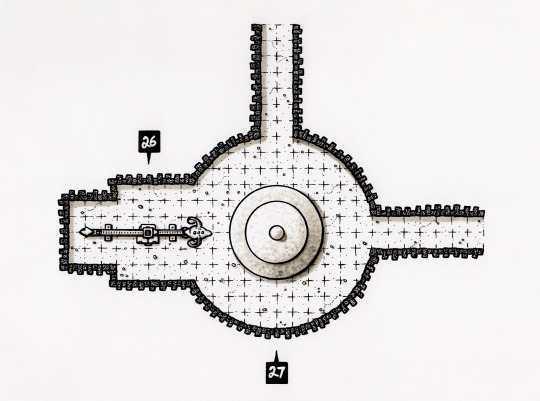
In one of my latest dungeon rooms, players can encounter a giant urn full of nanomachines. The Nanites can combine into several forms. I went for a 1D4 table in this case, wrote five options, then cut one.
Nanomachine Gestalts
1. Statuesque Humanoid: From a distance, the swarm appears human. Tall and graceful, gleaming with reflected light. Up close, the figure takes on an alien appearance, its proportions exaggerated, its face grotesque.
2. Kaleidoscopic Lattice: Arrays of Nanomachines chain together, rapidly filling the room with a complex matrix of crushing fractals. Passage through the area becomes increasingly dangerous.
3. Electric Amoeba: An amorphous shape, its iridescent volume warps and quivers in all directions. Appendages appear and disappear as it blindly probes the room.
4. Monolithic Geometry: Cubes and other angular shapes form a mass of intersecting surfaces, reflecting the world around it. New structures erupt like animated pyrite, extending to unexplored passageways, while trailing offshoots reconstitute into the primary locus.
5. Simulacrum: The Nanomachines appear as a cloud of iridescent dust. Several are inhaled by a member of the adventure party, entering their bloodstream and brain. The remaining Nanites will fill the room, creating a space based on the adventurer’s memory, for all to see.
I ended up cutting #3 from the available options. It was too similar to option #4 in form and function. Plus I wanted to push the “machine” aspect in nanomachine. Really, #3 inspired me to write #4 – a classic blob monster, but more mechanical? Of course. Giving the encounter a more organic bent could have been interesting? But I thought the humanoid form in option #1 filled that niche well enough. Given every other option, #3 didn’t have a lot going for it. Overall, I think the table is stronger without it.
And I just want to say…
Why’s it gotta be so hot? I’m so unproductive in the summer. Any amount of heat seems to sap my motivation. So, a perfect time of year to wrap up a mega-dungeon. And yet, progress has been made. I just cracked 200 pages on my latest project, The Electric Triptych of the Tetric Necromancer. By the end of next month I should have all 12 (out of 12) areas laid out and edited. After that, I’ll want to draft an introduction, a timeline of events, a few adventure hooks and such, but the entire dungeon will be playable from start to finish. That’s something.
Stay cool, people.
#ttrpg#dungeon23#ttrpg maps#dnd#indie ttrpg#ttrpgs#osr#drawing#ttrpg art#inkdrawing#writing#creative writing
16 notes
·
View notes
Text
Ludo-Labo
Running and playing pre-written adventures, I don’t think I always clue in to what makes an encounter effective, not “in the moment”, anyway. I’m too focused on the moment itself to parse why what’s on the page is translating into a good time. After reviewing the text, post-session, one key ingredient seems to be whether or not the text is providing enough information to telegraph danger to players. It’s not something I always do consistently well in my own writing, but it’s something I’m more mindful of lately.
For example, I’ve just completed edits on a hazards table, where players encounter a room full of crates filled with dangerous chemicals in a laboratory setting. Originally, I focused on the hazards themselves, describing the effects of the chemicals, and what happens when the players are already exposed to the danger.
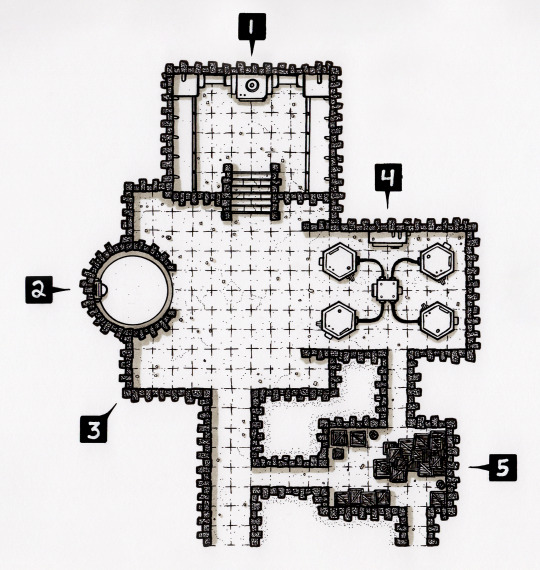
We're talking about room #5 here.
On the second pass, I made sure to include simple details, to alert the players to potential danger, or a way for them to react, or avoid the danger, even if they were unsure of the specific outcome.
Let’s have a look at each.
Chemical Hazards (1D6):
Incendiary Tar: A dark sludge slowly expands, creeping into adjacent rooms. The slightest spark will set the mud ablaze. This one is fairly visual, easy for players to spot. There’s nothing really to tell them that it is tar, or that it is flammable, perhaps an odor could be written into this, to make it clearer. But the fact that the tar expands slowly gives players time to react, even if they do throw a fireball at it.
Explosive Reaction: Chemicals stored here are marked as highly volatile, the slightest impact will cause a violent explosion. Here, the danger is much more sudden, explosions happen fast! Big warning signs filling the room are easy to notice and avoid. Perhaps the players could use this knowledge to their advantage, setting a trap.
Noxious Gases: Spending any time in this room will cause one to become light headed, intense nausea is soon to follow. While not immediately evident, the gradual sickness helps to alert players to a more severe outcome, allowing them the chance to escape the area.
Acid Puddle: Recklessly treading through this room, the soles of one’s boots will be eaten away after a few minutes. This one is probably the least telling, and speaks more to the GM than the players, leaving more work for the GM to make it fair. I’ve not explicitly written what the hazard is here, or how it might be noticed. But the stakes are not as high either. It takes some time for the acid to take effect, and, at worst, they are out of a pair of shoes. Still, I’ll admit, it’s the worst of the bunch.
Oxidizing Vapor: A pungent, yellow cloud fills the air. All metal will rust after a few minutes of exposure. A tell that’s a bit more overt, featuring sight and smell, to alert players in multiple ways. The stakes are higher here, strolling through this room is likely to damage a players armor and weapons, making them less effective overall.
Liquid Nitrogen: A pale mist wisps across the floor. The air becomes colder upon approach. Exposed skin will become frostbitten within seconds of stepping into this room, joints will seize soon after. Pale mist on its own might not be much of a warning, depending on where players encounter it, but given that this is an indoor area, that should put them on alert. If that’s not enough, the addition of increased cold as players approach should make it especially clear that this is not a normal room.
I could probably keep editing forever, but at the moment I’m feeling good with my progress on this kind of thing. Being able to identify that things could be better is a good place to be. I’m willing to bet that it means things will be even better on the next adventure.
I'd love to see some good examples of telegraphed danger in TTRPGs, hit me up with your favorites!
22 notes
·
View notes
Text
An Audience with The King
I don’t even talk about kings in this post, but the North Keep has been added to my mega-dungeon, and there’s a throne room in there. That’s nine out of 12 locations, just three more areas to go and all my #dungeon23 work will be compiled into a single document. Feeling good about things, just need to keep up this pace.
The North Keep is a central location, where some very heavy encounters can intersect. Let’s dig in.
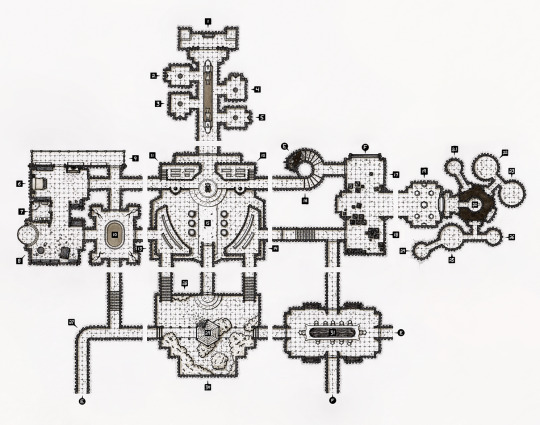
On the west side of the area, we have a pool of amphibious parasites who use human hosts as incubators to metamorphose into their final form. When I first wrote the draft for this encounter last year, I felt like it was one of my best, so I was really happy to return to it again. An “Alien” trope in a lot of ways, for sure, but I was digging my spin on it.
The atmosphere of the bathhouse area is creepy in both the map image and the writing. It was nice to lean into some classic horror elements, which I have not really used in the mega-dungeon so far. At least not to this degree.
I think this work over the past year (and then some) has made me really think about pacing and encounter variety. There are definitely some recurring themes and encounters in my mega-dungeon. And in the past, with smaller dungeons/adventures, I tended to focus on asking myself if the themes and encounters were cohesive, if they felt like they belonged together.
But now I’m thinking, does making things cohesive also risk making them boring? Or predictable? Is there enough variety in the themes and encounters to keep things interesting for the players?
Even just editing this bathhouse/parasite encounter has made me really appreciate the “spike” that can occur here, where something truly different can happen. I’m thinking players will enjoy that, too. Something I’m going to be thinking about the next time I write, for sure. Structured, cohesive themes, and whether or not I’m building in opportunities to break out of that structure when needed.
Ok, so that’s the west side. On to the east side, the dining hall. I’ve had this idea in the back of my mind for a while, for a “wizard party” encounter. In most adventures, players usually deal with one main antagonist. “Evil Wizard” is a classic, of course. But what if, unbeknownst to the players, that the evil wizard happened to be throwing a dinner party with all their evil wizard friends? The players have been expecting to find one evil wizard, but now they’ve run into four, each with different personalities and abilities. And they’re not going to take too kindly to the interruption. That’s the premise of the east dining hall encounter. I’ve mixed it up with six arcane egomaniacs to add to your guest list.
There’s a lot more in the North Keep, the page count is higher than any other area so far. There’s a big boss battle that opens up access to the next floor, a vault full of treasure (basically a mini-dungeon on its own), and a big ol’ chunk of background for the setting, that explains how things got to this point (if you’re into that kind of thing). It’s nice to get all of this out of my head and onto a page, finally. The first draft was almost like creating 365 dots. Now I’ve had a chance to connect a lot of those dots.
---
What Have I Been Reading?
The Choir By Mobile Hut (Evlyn Moreau, Lett Morrison, Casey Jones, Roxanne B.)
Picked this up at the beginning of the month. I’ve been a fan of Evlyn Moreau’s work for a long time and she always manages to work with an amazing crew of collaborators. This is a short, solid, adventure for Mörk Borg with a touch of investigation and a unique “spooky house” to punctuate the session. Lots of little twists and turns, and a good cast of NPCs with clear connections for the players to bump into.
A clever highlight for me was an encounter mechanic that states: After an encounter, the player character who was the most passive receives a Blood Forest Vision. And then there is a table of unique visions to roll on.
Really loved this, beyond the fact that the visions give the players a glimpse into what’s coming their way, it also gives a more laid back player a special moment that they can play out however they want.
I definitely recommend this one if you’re looking for a short adventure. Even if you don’t use it for Mörk Borg, I’m sure it could be easily adapted.
16 notes
·
View notes
Text
Creep Crypts, Read Books
Added the eighth area on my mega-dungeon, the Monastery, in The Electric Triptych of the Tetric Necromancer. I found I spent less time editing this area compared to other areas so far. Not sure if that’s any indication of good writing, but I think it’s an indication of writing that I’m happy with.
Players are likely to encounter a religious cult here, formed to strengthen the Tetric Necromancer’s influence. These Electric Priests are largely a warm-up obstacle before some of the prime objectives in the mega-dungeon are revealed. Namely, one of the Electric Triptych panels, as well as the Undead Queen. If you’ve been following along, these are two key adventure hooks, making the Monastery an area meant for both climax and reward.

Working in a faction of “Old Gods” was fun as well. A giant, stone sphere made of distorted faces that communicates through telepathic whispers. I went with a sort of ambivalent trickster theme with them, gods that know they are all powerful, but are also powerless, since they are no longer in fashion. They also touch on the themes of magic versus technology that I’ve been exploring with this adventure. Where technology is sort of becoming the new magic that everyone is used to in this world.
The Monastery also expands on some of the world outside of the mega-dungeon, giving more background on Shorevale, a fishing village, and Archedahn, a town of aristocrats. Both locations suffered a grave decline after a visit from the Undead Queen. Adding a fishing village is largely an excuse to create a future adventure that includes a lighthouse, because lighthouses are cool. Both locations are south of the Citadel, where the main adventure takes place.
Oh yeah, and I changed the name of the main structure in the adventure from “Spire” to “Citadel”. So if you have a previous copy, the Spire is no more. It’s all Citadel all the time, now. After giving it some thought, the mega-dungeon wasn’t much of a tower, so “spire” didn’t really fit. While there are technically five vertical levels, only three of them are above ground. It’s kind of diamond shaped, overall? Maybe I’ll change it again, I don’t know. You’re seeing this come together right around the same time I am. The reality is, even after it’s “done”, I’ll still be thinking about what to call it. Forever.
Come August, when I intend to have all of the main areas added to the book, I’ll spend some time on “Phase 2” items. A simple mini-map, with all the dungeon areas combined, just to show the general structure and flow of everything. A simple overworld map might be good too, showing a few key locations surrounding the mega-dungeon, to allow for some lead-up to the primary adventure. I’ll want to spend some time writing a basic intro and some adventure hooks as well.
Other Things Speaking of hooks, I picked up Dragonbane a little while back. They have a random quest generator in the back of the core book, not sure I’d use it as is, but I was a bit inspired by it. It’s like a phrase builder, along the lines of: One day in the [market], the party happens upon a [rumor] from [John Stinktooth, a thief] who wants to [destroy] a [magical artifact] called [Butcher’s Bone]. The brackets can be filled in by a variety of words generated with dice rolls. Not mind blowing, it’s a bit of a jumble, but got me thinking.
I’d probably approach it less like a phrase and more like a list of keywords, or maybe the answers to a set of questions that generate a hook? Tables of objectives, NPCs, items, locations, etc. Things relevant to the adventure itself. Leave some room for the GM to fill in the gaps. Yeah, I think I might want to try and build something like that.
A Shout Out to Mini GM Screens Also, just received the new Mothership box set today (the small one) and wanted to mention the mini Warden screen that was included. Three panels, roughly 5.5” tall and 25.5” wide, end to end. I generally don’t use GM screens, and if I do, it’s not for the purpose of hiding anything, I’m more interested in the reference materials they display. I find reference booklets more my jam. But the form factor of the tiny Warden screen from Mothership might win me over. It’s something I’d probably just lay flat on the table for reference. Reference material with a small footprint and the ability to fold up even smaller – more of that please.
11 notes
·
View notes
Text
Room Service
Another month, another area of my mega-dungeon compiled. The Servant Halls are now part of The Electric Triptych of the Tetric Necromancer!
Seeing the PDF page count hit triple digits last month was something else. The fact that it will reach 200+ pages in the next few months really puts things into perspective. This has been (and will be) a lot of work! Fortunately I’ve enjoyed the ride. Going back to the original drafts from 2023, spending time with the text and expanding on things to make connections, has really helped me to flesh out the layers in the adventure overall.
In this recent area, when I looked back on the draft, I was a bit worried that I’m not adding enough specific confrontation, that problems for the players were only implied, not overt. What’s to stop them from walking right past an encounter? That said, I’m often inclined to leave room for things that just “are”. Not everything needs to be a problem. Not everything needs to be encountered. Sometimes a space is just a space. Especially in something like a mega-dungeon, I think there’s room for that type of experience.

The Service Halls are a bit of a breather in that regard. The Servitors in this area of the mega-dungeon are not inherently “bad”. Neither are the Ganglios Creatures they use as livestock (though they will eat you, if you get too close). Random events could potentially throw up some roadblocks, but it’s also just as likely the players could spend their time here resting, getting to know some of the NPCs, and exploring the setting. Probably for the best, given the adjoining areas (the Dungeon and the Monastery) are designed to be more lethal.
I keep coming back to the balance of these concepts over and over, that there is somehow more “value” in conflict. But is there?
There’s the dungeon building philosophy of having “empty” rooms. As a matter of pacing, I think this is good advice. If every room is a fight, players may find it difficult to press on. Of course “empty” rooms are not actually empty, they may have a minor event, a clue, foreshadowing, or some other means of establishing the setting. In some ways, the entire area of the Servant Halls serves this purpose.
This area is likely to be mid-game for most players running through the mega-dungeon, so it feels like the right time to throw in a bit more detail about the “end boss”. A lot of this area is about letting players know what kind of person the Tetric Necromancer is. Namely: A failed wizard who relied on grotesque shortcuts to serve the kingdom, and the harm he is capable of causing in the pursuit of his ambitions.
The Servant Halls also help to expand on the backstory of the Undead Queen, a major plot point in the setting’s history, available if the players care to dig into it. The Undead Queen is sealed away in the Monastery, adjacent to the Servant Halls. So, at the very least, I felt a bit of foreshadowing was in order. I’ve not officially written any hooks for this adventure, but finding the fate of the Undead Queen is likely to be one of them.
I could see the players given quite a few opportunities to gain allies or tag-alongs in the Servant Halls as well. I’ve set up what I think are two strong possibilities.
1. Delos, a time traveller who is looking for their partner, trapped deeper within the dungeon.
2. Molly, a Servitor who is no longer under The Spire’s control, who is capable of assembling a small army of fellow Seritors. Molly also has a connection to another area higher in the Spire (the Laboratory), where more Servitors await.
In both cases, there is a reunion waiting to happen. I thought that might be a nice payoff, instead of the usual reward of treasure. Again, nothing overtly mentioned, but I’m happy for the GM and players to unpack these connections through play.
And yeah, time travel! I’ve wanted to write a proper time travel adventure for a long time, but find the mechanics quite difficult to pull off in a way that doesn't get confusing. So I’m just dabbling here. If you read or play this portion of the adventure, let me know what you think. And if you have any time travel adventure recommendations, send them my way.
The addition of the Servant Halls also marks the first time in a while when all of the existing areas in the mega-dungeon are connected by contiguous paths. The Dungeon and Sewers were a bit of an island for a while (unless you count the secret Sewer fountain entrance in the Gate House). The Servant Halls make a direct connection to the Dungeon now, which connects to the Sewers. Once I get the Monastery and the North Keep added, that’ll be everything on the ground floor, available for play. Then we get to do the final climb up The Spire, to the top.
A mega-dungeon with a big ground floor? I dub it “the dungeon sprawl”.
8 notes
·
View notes
Text
Last Call at the South Keep
The South Keep was originally completed in May 2023, as part of #dungeon23. The combined area has now been added to the PDF, along with an accompanying set of 20 random happenings.
This is also the first time in months that I’ve revisited editing of the mega-dungeon as a whole, rather than focusing on daily room keys. As part of that, I’m adding overlapping prompts and encounters to hook players from one major area to the next. This is a lot easier now that each room is complete and I know the bounds of the entire mega-dungeon.
I’ve also played with the formatting a bit, added a few quality of life changes to the layout. Fixed lots of embarrassing typos, and undoubtedly added new ones that will be even more embarrassing! I have a bad habit of adding and removing nouns and adjectives that result in an “an” somewhere that should be an “a”, or vice-versa. All that to say: Edits continue.
For areas that do not yet exist in the PDF, or pages that may shift, I’ve left placeholders, referenced as “##”. These will be filled in as new areas are added. I’m not sure if it’s more preferable to get updates monthly, or if people would rather get areas in larger batches, two or three at a time? Either way, I’m working towards having all 12 areas compiled, edited and added to the PDF by the end of the summer in 2024.
Back to the South Keep. This post will include some behind-the-scenes thoughts that will make more sense if you’ve read through the area at least once, but I’ll try to include some context regardless.
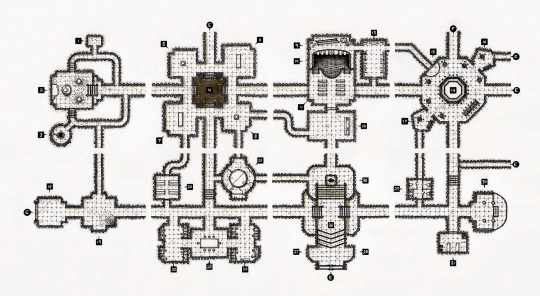
The layout of the South Keep is probably the least interesting to me, it ended up pretty boxy, the “pages” really stick out here. But the encounters ended up being some of the most bizarre and entertaining keys I’ve written, so that redeems it for me. Some of the mega-dungeon’s narrative gets fleshed out here, too. There’s a lot going on.
This segment of the adventure is a bit of a refuge for adventurers, a place to take a breather. Not to say the South Keep is a cakewalk, but my focus was to lean into weird encounters, rather than fatal combat scenarios. As a matter of pacing, the Gatehouse and Factory that surround the South Keep are much more dangerous, and it’s likely players have just passed through one of those areas to get here.
From the south entrance, the narrative builds on how The King has been dethroned. In the entry hall, there is a statue of the monarch with their head missing. This continues the theme presented earlier in the Gatehouse garden, where it’s shown that members of the royal court had turned on The King.
From the west entrance, things are a little more random. There’s a “disturbed” spot on the floor. At the very least, it shows how the keep is decaying, where a sinkhole might appear. This place is old. Another more interesting option establishes the presence of a Clerical Beast who roams the South Keep. This creature was inspired by the administrative offices, found further in, and may show up as a random happening. This area may also be the first sighting of Nanomachines, which play a larger role later in the mega-dungeon.
The concept of the players spending a lifetime as a nano-proxy was a riff on the old Star Trek TNG episode “The Inner Light”, where Picard is rendered unconscious for a few minutes, but experiences an entire lifetime on an alien world. Or maybe that “Hard Time” episode of Deep Space Nine, where O’Brian is falsely convicted for a crime, and as punishment he is implanted with memories of being imprisoned for several years. Some kind of mash-up along those lines. I resisted adding a flute or a sympathetic doctor.
The major factions in this area are the Office Automatons and the staff and patrons of Dillo’s Bar. There’s a chance that neither of these groups ever interact, but I’ve set up a lot of dominoes here. Add the players to the mix and something is going to topple.
The Office Automatons as non-player characters don’t garner a lot of sympathy, but do flesh out the administrative nature of mega-dungeon. I think it’s more likely that players will gravitate to Dillo’s side of the keep where they can take on quests to delve deeper into the dungeon.
The ultimate showdown between the Office Automatons and Dillo’s Bar is if the second “Order of Business” event is triggered. This is where The Spire’s Administration has decided to send in guards to shut down Dillo’s by force, creating a standoff for the players to get wrapped up in.
An aside: Speaking of random things, I don’t know why nested random tables appeal to me so much, but I love writing them. Burying elaborate events behind improbable chance just feels good. A 1-in-100 chance of a good time makes it a great time. It’s probably near the same part of the brain where rolling a crit lives.
And then there’s the theater. The main stage area sets up more of the narrative for the dungeon itself. Establishing the undead Queen who will show up later in the Monastery, establishing how the Tetric Necromancer thinks highly of himself, as the rightful ruler of The Spire. More King bashing. Elements of propaganda through technology, etc. That all fits fine.
What didn’t fit in the theater was the addition of Guilfoyle’s Ghost. But I ain’t mad. I sort of fell in love with the concept as I was writing it, a thespian ghost whose play is slowly eating the real world. Then I ran out of space to really do it justice (trying to keep each area contained on one page). I hope it’s a concept that a game group can take and expand on. It’s a bad situation that’s easy to stumble on, and could easily end a run if players are unable to resolve things. I especially liked it because it’s high-stakes but doesn’t inherently involve fighting. It’s more like a trap you can reason with. And that’s pretty cool. A concept worth exploring further in the future.
Before I wrote the theater, I wrote the gallery. I basically wanted a “weird event” generator. The paintings on the walls come alive and create a situation for the players to navigate. Resolving the situation grants them some kind of item as a reward. A bit of a slot machine, I suppose. A lot of the painting descriptions are based off of dreams I’ve had, visuals that have stuck with me over the years. Have fun with them.
I don’t have a lot to say about the Recess of Finance. Depressed bank machines just seemed amusing to me.
And lastly, the Morning room, a chill place to rest. I think it would be nice to end a session there, have the party sleep, and when they wake up their wounds are mended. With the side effect of being covered in geometric tattoos, caused by the magical healing properties of the stained glass windows.
I’m going to sleep now, too. See you in the next area!
21 notes
·
View notes
Note
This was a really cool thing to follow throughout the year, thank you for sharing it with us!
Thanks for coming along for the ride. :]
2 notes
·
View notes
Text
Y’know, Tumblr, I wasn’t sure what to expect when I jumped on here earlier in the year, but of the 9 platforms I’m repeating myself on these days, I gotta say, I’m into what you’ve got going on here.
Thanks all who followed along with my work, I’m very grateful and humbled by the interest and support I’ve received this year. I appreciate it, and I appreciate you!
Be good to yourself and to each other!
See you next year!
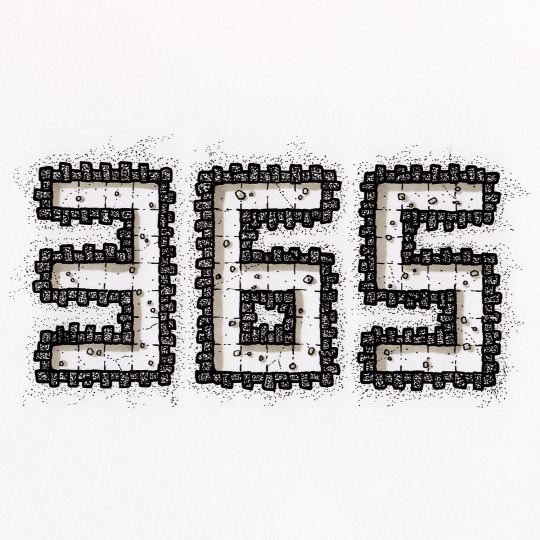
6 notes
·
View notes
Text
12.31. The Electric Triptych
Three empty recesses line the wall. Along their perimeters, rows of pin sockets, each with a unique pattern. Behind each recess, a sealed vault encased by the finest steel.
Adventure parties who have collected any portion of the Electric Triptych can plug their panels into the corresponding recess at this time.
West Panel - Memory of the Machine
Found in the Factory. Inside the vault: Magnetic film encased in a plastic sleeve. Time has degraded its contents. If read, what little can be recovered shows that the information is not from this century. It holds the first sliver of knowledge that Baltharius recovered from the future.
Introducing this knowledge back into the time stream may undo any attempts to thwart the Tetric Necromancer’s evil schemes.
Center Panel - Preservation of the Flesh
Found in the Northern Keep. Inside the vault: A ring granting immortality, for as long as it is worn. Once removed from the owner, the body will age rapidly.
Especially troublesome in the hands of an ephemeral clone who may wish to usurp their creator.
East Panel - A Bargain with Death
Found in the Monastery. Inside the vault: An amulet capable of bringing the dead back to life, though a bargain must be struck first.
The amulet was once used to revive the Queen from death — to a state of undeath.
When all three panels are added to the triptych, they complete a circuit and become electrified to the touch. Each vault can now be opened, unlocked by a phrase uttered by only the Tetric Necromancer himself.
/end dungeon
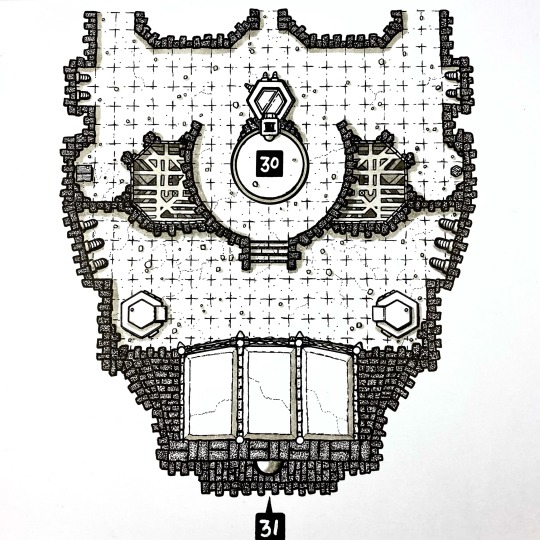
13 notes
·
View notes
Text
12.30. Receiving Hall
The circular plane functions to take passengers and cargo to the level below. As the elevator rises, an intense drone grows louder, accompanied by electric-sounding convulsions.
Within the circuitry-pits, flanking each side of the elevator shaft, electricity arcs across the intricate metal lattice.
In the west alcove, a small shelter has been constructed, empty. In the east alcove, a spent battery cell, bolted to the floor.

13 notes
·
View notes
Text
12.29. Reel Sequencing
Machines used to construct sentences from the words and phrases recorded on the reel-to-reel players in the outer ring of this area. Input is done at the central console. When a sequence is complete, it can be broadcast to the studio to the west.

12 notes
·
View notes
Text
12.28. The Brain Chamber
A brain, suspended in a glass cylinder.
Surrounding the cylinder: Life support, a reel-to-reel recorder, a small box with a living mouth in it.
The brain and mouth are cloned parts of the Tetric Necromancer.
When new speech segments are needed, the brain will be coerced to record the necessary line. The mouth produces an authentic likeness of Baltharius’ voice.
If the cloned parts had the chance, they would attempt to usurp Baltharius.
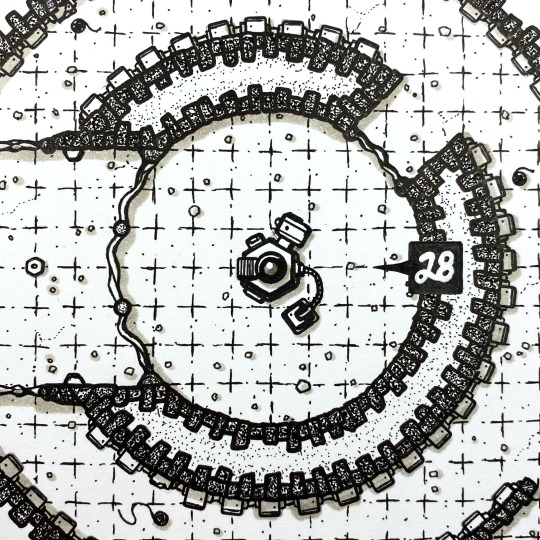
5 notes
·
View notes
Text
12.27. Reel Ring
Lining the walls of the outer ring in this area, dozens of reel-to-reel audio players. Each has a set word or phrase recorded to it.
When activated in sequence, the reels provide cryptic speech to accompany the visual broadcast in the studio to the west.

14 notes
·
View notes
Text
12.26. Studio
Curtains of leathery tissue seal this area. Inside, a rudimentary film studio has been set up. On the east side of the room, a holo-projector, capable of creating life-like scenes and figures. Audio is supplied by a set of omnidirectional speakers.
When the adventure party enters the room, a broadcast is in progress. An address from a holographic rendition of the Tetric Necromancer, demanding that the intruders be captured immediately!

4 notes
·
View notes
Text
12.25. Stairwell
A spiral stairwell leads to the floor below. Translucent layers of cobweb choke the passage.

6 notes
·
View notes